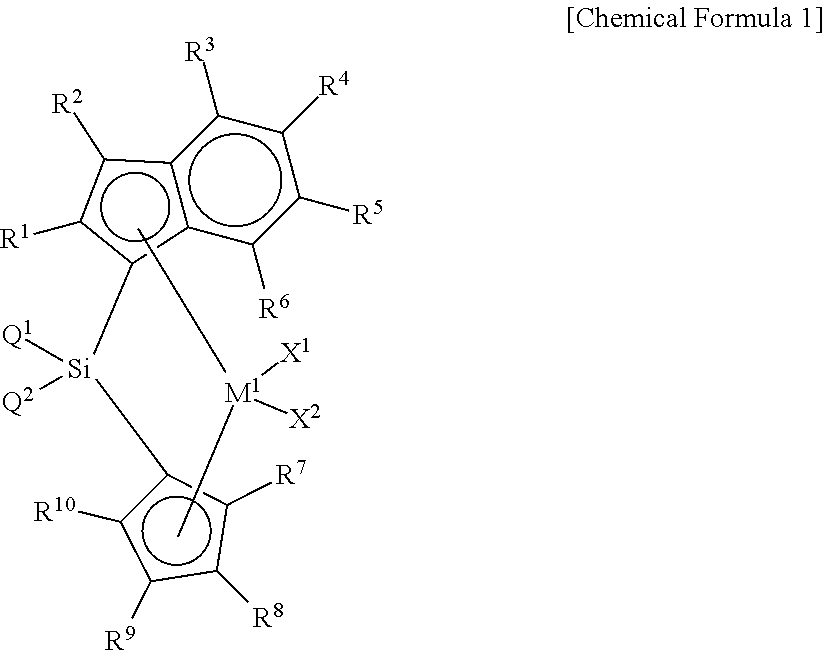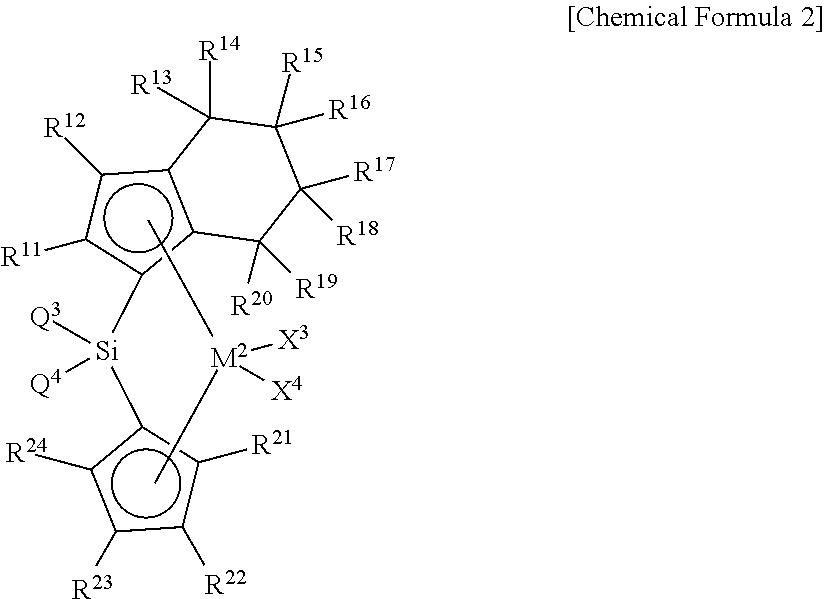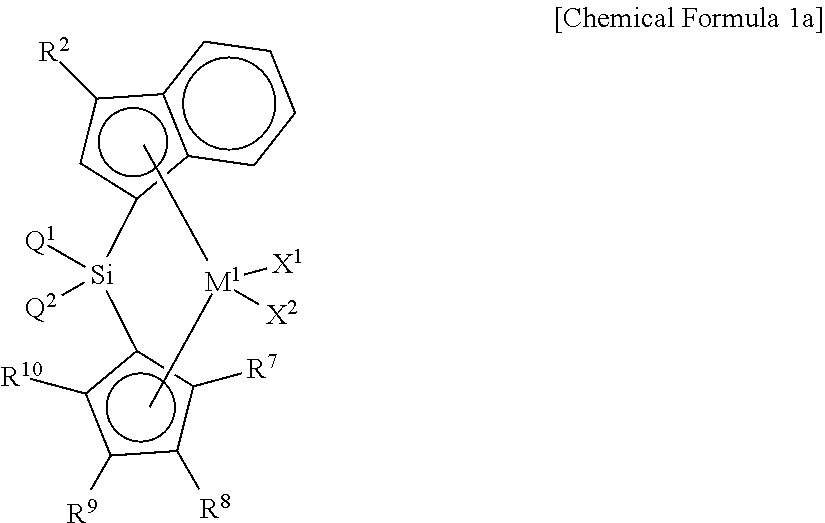Supported Hybrid Catalyst
a hybrid catalyst and supporting technology, applied in the field of supported hybrid catalysts, can solve the problems of poor morphology of polymers, difficult to obtain desired physical properties, complicated supporting procedures, etc., and achieve the effects of improving melt strength, easy preparation of polyolefins, and high transparency haz
- Summary
- Abstract
- Description
- Claims
- Application Information
AI Technical Summary
Benefits of technology
Problems solved by technology
Method used
Image
Examples
synthesis example 1
n Metal Compound
[0150]
[0151]Tetramethylcyclopentadiene (TMCP) was filtered after lithiation with n-BuLi (1 eq.) in tetrahydrofuran (THF, 0.4 M), and used as TMCP-Li salts. 3-phenyllndene (3-Ph-Ind) was filtered after lithiation with n-BuLi (1 eq.), and used as 3-Ph-Ind-Li salts. 50 mmol of TMCP-Li salts and 100 mL of THF were added to a 250 mL Schlenk flask under Ar. 1 eq. of (CH3)2SiCl2 was added thereto at −20° C. After 6 hours, 3 mol % of CuCN and 3-Ph-Ind-Li salts (50 mmol, MTBE 1M solution) were added at −20° C. and reacted for 12 hours. An organic layer was separated with water and hexane to obtain a ligand.
[0152]The synthesized ligand (50 mmol) was dissolved in 100 mL of methyl tert-butyl ether (MTBE) under Ar, and 2 eq. of n-BuLi was added dropwise at −20° C. After 16 hours of reaction, a ligand-Li solution was added to ZrCl4(THF)2 (50 mmol, MTBE 1 M solution). After 16 hours of reaction, the solvent was removed, and the residue was dissolved in methylene chloride (MC) to re...
synthesis example 2
n Metal Compound
[0154]
[0155]Tetramethylcyclopentadiene (TMCP) was filtered after lithiation with n-BuLi (1 eq.) in tetrahydrofuran (THF, 0.4 M), and used as TMCP-Li salts. 50 mmol of TMCP-Li salts and 100 mL of THF were added to a 250 mL Schlenk flask under Ar. 1 eq. of CH3PhSiCl2 was added thereto at −20° C. 50 mmol of 3-butylindene (3-Bulnd) and 100 mL of THF were added to another 250 mL Schlenk flask under Ar, and 1 eq. of n-BuLi was added dropwise at −20° C. After 16 hours, 3 mol % of CuCN was added to a lithiated 3-Bulnd solution, and stirred for 30 minutes. This solution was added to the first flask at −20° C., and reacted for 12 hours. An organic layer was separated with water and hexane to obtain a ligand. The synthesized ligand (50 mmol) was dissolved in 100 mL of MTBE under Ar, and 2 eq. of n-BuLi was added dropwise at −20° C. After 16 hours of reaction, a ligand-Li solution was added to ZrCl4(THF)2 (50 mmol, MTBE 1 M solution). After 16 hours of reaction, the solvent was ...
synthesis example 3
n Metal Compound
[0157]
[0158]Tetramethylcyclopentadiene (TMCP) was filtered after lithiation with n-BuLi (1 eq.) in tetrahydrofuran (THF, 0.4 M), and used as TMCP-Li salts. Indene was filtered after lithiation with n-BuLi (1 eq.) in hexane (0.5 M), and used as Ind-Li salts. 50 mmol of TMCP-Li salts and 100 mL of THF were added to a 250 mL Schlenk flask under Ar. 1 eq. of (CH3)2SiCl2 was added thereto at −20° C. After 6 hours, 3 mol % of CuCN and Ind-Li salts (50 mmol, MTBE 1M solution) were added at −20° C. and reacted for 12 hours. An organic layer was separated with water and hexane to obtain a ligand.
[0159]The synthesized ligand (50 mmol) was dissolved in 100 mL of MTBE under Ar, and 2 eq. of n-BuLi was added dropwise at −20° C. After 16 hours of reaction, a ligand-Li solution was added to ZrCl4(THF)2 (50 mmol, MTBE 1 M solution). After 16 hours of reaction, the solvent was removed, and the residue was dissolved in methylene chloride (MC) to remove LiCl. The solvent of the filtrat...
PUM
| Property | Measurement | Unit |
|---|---|---|
| thickness | aaaaa | aaaaa |
| melt strength | aaaaa | aaaaa |
| temperature | aaaaa | aaaaa |
Abstract
Description
Claims
Application Information
 Login to View More
Login to View More - R&D
- Intellectual Property
- Life Sciences
- Materials
- Tech Scout
- Unparalleled Data Quality
- Higher Quality Content
- 60% Fewer Hallucinations
Browse by: Latest US Patents, China's latest patents, Technical Efficacy Thesaurus, Application Domain, Technology Topic, Popular Technical Reports.
© 2025 PatSnap. All rights reserved.Legal|Privacy policy|Modern Slavery Act Transparency Statement|Sitemap|About US| Contact US: help@patsnap.com



